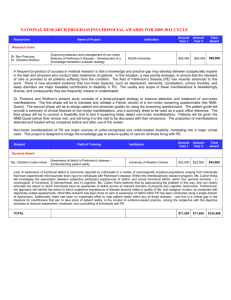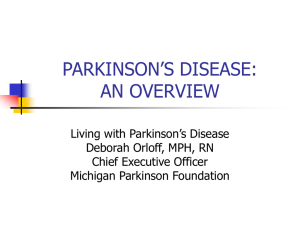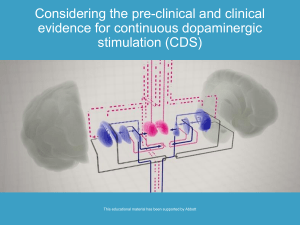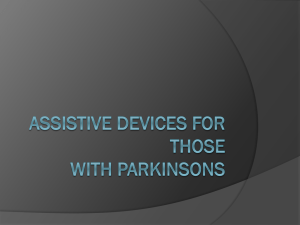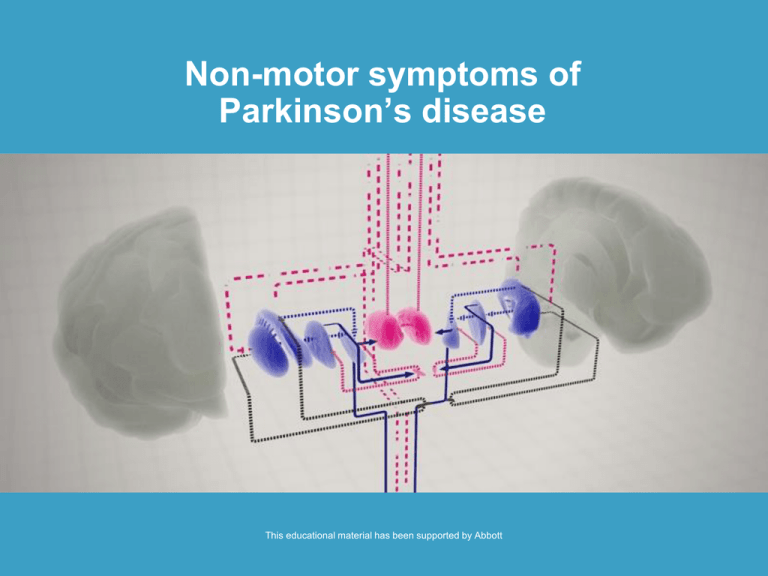
Non-motor symptoms of
Parkinson’s disease
This educational material has been supported by Abbott
Non-motor symptoms of Parkinson’s disease:
Patient burden
Sensory
disorders
Autonomic
dysfunction
Neuropsychiatric
disorders
Gastrointestinal
disorders
Non-motor
symptoms
(NMS)
Urologic
disorders
Sleep
disorders
Orthostatic
hypotension
Adler CH. Mov Disord 2005;20(Suppl 11):S23-9 .
e.g. psychosis,
depression, anxiety
and dementia
Significant changes in sleep pattern in
MPTP-treated monkeys
Barraud Q, et al. Exp Neurol 2009;219:574-82.
Significantly higher proportion of NMS in
patients versus controls
Chaudhuri KR, et al. Mov Disord 2006;21:916-23 .
Higher prevalence and wider range of
NMS in Parkinson’s disease
In a recent global study, nocturia was identified as the most prevalent non-motor symptom
in patients with Parkinson’s disease
Martinez-Martin P, et al. Mov Disord 2007;22:1623-9. Chaudhuri KR, et al. Mov Disord 2006;21:916-23.
Prevalence of NMS according to
Parkinson’s disease status
Non-motor symptoms common across all stages of Parkinson’s disease
Barone P, et al. Mov Disord 2009;24:1641-49. Copyright (2009 Movement Disorder Society); Reproduced with permission of John Wiley & Sons, Inc.
NMS in Parkinson’s disease:
Association with gender age and disease duration
Logistic regression analysis revealed a significant correlation of orthostatic hypotension and
urinary incontinence with age and disease duration
Correlation with age and disease duration
(odds ratio)
Symptom
Male
(N=2076)
Female
(N=1338)
Sexa
Ageb
Disease
durationb
Orthostatic
hypotension
10%
11%
NS
1.03
(1.02-1.05)
1.02
(1.00-1.05)
Urinary incontinence
21%
22%
NS
1.04
(1.03-1.05)
1.04
(1.02-1.05)
Sexual dysfunction
30%
8%
0.09
(0.06-0.12)
1.02
(1.01-1.03)
NS
Erectile dysfunction
50%
1.04
(1.02-1.05)
NS
Sleep disturbance
35%
NS
1.03
(1.02-1.04)
aOdds
43%
<1 is equivalent to decreased risk for women
bIncrease
of risk for 1 year of age or disease duration
NS = non-significant
Wullner U,, et al, et al. Eur J Neurol 2007;14:1405-8.
1.42
(1.23-1.64)
Most common non-declared NMS
(N=242)
Chaudhuri KR,et al. Mov Disord 2010;25:704-9.
Effects of duodenal carbidopa/levodopa
gel infusion on NMS
The proportion of patients with advanced Parkinson’s disease with improving health
status and improving quality of life as measured by sleep, NMSS and PDQ-8
Honig H,et al. Mov Disord 2009;24:1468-74.
Total score
Effect of apomorphine on NMS
Naidu Y,et al. Mov Disord 2009;24(Suppl1):S360.
Continuous apomorphine infusion
improves NMS
Non-motor symptom improvement driven by improvement in sleep, mood, urinary,
gastrointestinal and miscellaneous domains
Martinez-Martin P,et al. Mov Disord Society Meeting 2010.
Summary
• Non-motor symptoms are highly prevalent in Parkinson’s
disease and are associated with poor quality of life
• In a recent global study, the most common non-motor
symptoms were nocturia, urinary urgency, and constipation
• Non-declaration of non-motor symptoms is common in
Parkinson’s disease, the most frequently non-declared
symptoms were delusions and day-time sleepiness
• Preliminary studies indicate the potential for alleviation of nonmotor symptoms and associated improvements in quality of life
with continuous dopaminergic stimulation
Quality of life
This educational material has been supported by Abbott
NMS are a major cause of poor
quality of life in Parkinson’s disease
The most prevalent non-motor symptoms causing impairment of quality of life among
patients aged 33 to 90 years
Non-motor symptom
% of patients (N=163)
Balance problems
51.5
Sleep disturbance
43.6
Anxiety
38.7
Urinary problems
32.5
Memory/confusion
31.3
Bowel problems
31.3
Dribbling of saliva
29.4
Speech problems
27.6
Adapted from Gulati A et al. Mov Disord 2004;19(Suppl 9):S403.
NMS correlate with deteriorating
quality of life
NMS Scale and
PDQ-39
Load of nonmotor symptoms
shows robust
correlation with
deteriorating
quality of life
Martinez-Martin P, et al. Neurology 2009;73:1584-91.
Spearman R = 0.70
NMSS score correlates strongest with
quality of life in 2 independent studies
NMSS-Study 1
PDQ-8
NMSS-Study 2
N = 242
Age
- 0.03
PDQ-39
EQ-5D
N = 411
Age
0.05
- 0.13
PD duration
0.26
PD duration
0.34
- 0.33
H & Y staging
0.41
H & Y staging
0.51
- 0.53
UPDRS-3
0.46
SCOPA-Motor exam
0.47
- 0.59
UPDRS-4
0.36
SCOPA-Motor complications
0.53
- 0.47
FAB-Total
- 0.39
- 0.41
0.34
SCOPA-Cognition
NMS Scale
0.70
NMS-Scale
0.70
- 0.57
NMS Quest
0.63
SCOPA-Autonomic
0.61
- 0.49
Fatigue-VAS
- 0.40
- 0.49
0.41
PDSS
Martinez-Martin P, et al. Mov Disord 2007;22:1623-9. Martinez-Martin P, et al. Neurology 2009;73:1584-91.
Efficacy of interventions on
health-related quality of life
Intervention
Efficacy*
Surgery
STN-DBS
Unilateral
pallidotomy
Likely
efficacy
Unlikely
efficacy
Insufficient evidence
No efficacy
Bilateral pallidotomy
Unilateral thalamotomy
Pallidal stimulation
Unilateral thalamic
DBS
Foetal
transplantation
Levodopa
Conversion from
standard to slow
release
Dopamine
agonist
Pramipexole
Cabergoline
MOA-B
inhibitors
Rasagiline
Selegiline
COMTinhibitors
Tolcapone
Entacapone
Anticholinergics
All
Amantadine
Amantadine
*Evidence of positive effect on health related quality of life based on at least one high-quality RCT and no conflicting data from other
RCTs. Evidence based on motor improvements.
Martinez-Martin P, Deuschl G. Mov Disord 2007;22(6):757-765. . Copyright (2007 Movement Disorder Society);
Reproduced with permission of John Wiley & Sons, Inc.
Long-term effect of duodenal carbidopa/
levodopa gel infusion:
Improvement in quality of life
Puente V, et al. Parkinsonism Relat Disord 2010;16:218-21.
Randomized trial of deep brain
stimulation for Parkinson’s disease
Deuschl G, et al. A Randomized Trial of Deep-Brain Stimulation for Parkinson's Disease. New England Journal of Medicine Vol. 355, No, 9 2006, p896908. Copyright © 2006 Massachusetts Medical Society. All rights reserved.
Summary
• Non-motor symptoms have a major impact on quality of life in
patients with Parkinson’s disease
• Long-term duodenal carbidopa/levodopa gel infusion treatment
alleviates many of the non-motor symptoms with a resultant
improvement in quality of life
• Long-term DBS also has a significant impact on non-motor
symptoms with an associated improvement in quality of life

